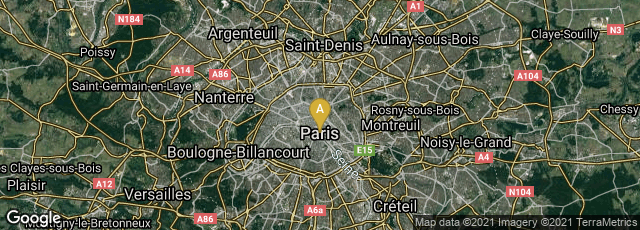

A: Paris, Île-de-France, France
In 1702 l'Académie Royale des Médailles & des Inscriptions issued Médailles sur les principaux événements du règne de Louis le Grand avec des explications historiques avec des explications historiques as an elegant folio volume printed in Paris at l'Imprimerie Royale. The edition was not for sale; rather copies were presented by the king as gifts. Most were in presentation bindings either of morocco (red or dark blue) or stained calf, emblazened with the royal arms. The author of this work was French scholar and numismatist Claude Gros de Boze.
Each page of this catalogue of commemorative medals struck during the reign of Louis XIV featured engraved images of the obverse and reverse of a single medal, followed by a lengthy description of the event upon which it was based. This grand and imposing publication was an artistic effort to enhance the king's image, rather than to provide an accurate historical record.
The volume marked the introduction of the Romain du Roi, the first “transitional” typeface, characterized by flat, unbracketed serifs, a greater emphasis on verticality and a higher contrast between thick and thin strokes. Commissioned in the 1690s by Louis XIV for use by the Imprimerie Royale, the typeface, designed by Philippe Grandjean, was the first to base its letterforms on a mathematical grid rather than on the more organic “old style” forms developed in the fifteenth century. As such, the Romain du Roi has been described as “the first digital font, and at least the first mathematically defined type” (Devroye). The Médailles was an expensive tour-de-force of printing: Each copy was said to have cost 400 livres to produce. Each text page contained, besides letterpress, at least three separate copperplates: An engraved border, separate engravings of the obverse and reverse of a particular medal, and engraved vignettes used when necessary to fill space. To print the letterpress a new printing press was designed for the purpose, one that would apply a smooth and even pressure to the type without any lateral movement. Remarkably, this most elaborate book was the first publication of Claude Gros de Boze, who was only 22 years old at the time of publication. It was the beginning of a most distinguished career. Sources differ as to the size of the edition: Some say 200 copies were printed, others say 500.
Mosley, “Médailles sur les principaux événements du règne de Louis le Grand (1702): The making of the book,” Bulletin du bibliophile (2008): 296-350. Devroye, Luc. “Philippe Grandjean De Fouchy.” On Snot and Fonts. N.p., n.d. Web. Accessed 12 Apr. 2016.